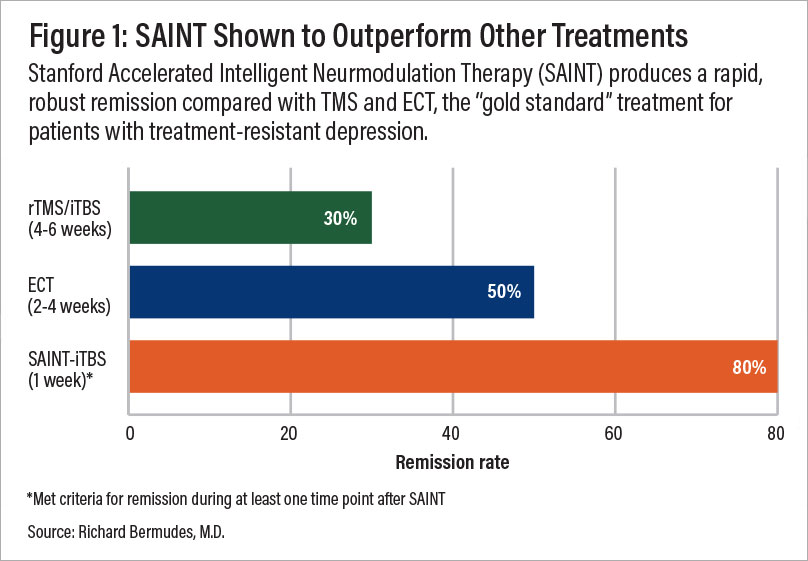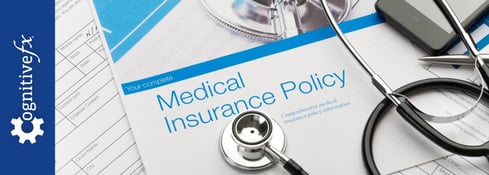What Does TMS Feel Like? (Complete Patient Guide)
If you’re considering Transcranial Magnetic Stimulation (TMS) — a procedure that uses electromagnetic pulses to improve depression symptoms — you may be wondering what the treatment actually feels...


Patients considering transcranial magnetic stimulation (TMS) often wonder whether or not they can continue taking their antidepressant medication while undergoing TMS treatment.
In most cases, the answer is yes. Patients can continue their antidepressant medication regimen during TMS. There is strong evidence to suggest that combining TMS and antidepressant medication is safe for patients and may even make TMS more effective.
In this article, we offer practical advice about when you may need to adjust your medication or consider potential side effects. We cover:
If you’ve been living with major depressive disorder (MDD), chances are you’ve already tried one or several antidepressant medications. These are the most common first-line treatments for depression, but antidepressant trials and systematic reviews show that only about one-third of patients achieve remission by using antidepressant medications alone, and even that may take years.
Despite these results, many patients are unsure about stopping their medication. Even if they’re not working as well as they should, they often still help with maintaining daily activities.
An option for these patients is to undergo TMS therapy while continuing to take their medication. Rather than replacing it, TMS works alongside the medication, helping to stimulate the brain pathways involved in mood regulation. This adds another layer of support when medication alone isn’t enough.
For many patients, the most effective treatment plan includes:
Staying on existing antidepressant medications, as long as they’re safe and don’t cause side effects due to drug interactions.
Adding TMS to stimulate brain activity and improve neural function.
Some researchers have found that combining antidepressant medications with TMS can help patients experience more sustained outcomes compared to either treatment option in isolation.
Further research is needed to understand the interactions between both treatments, but the following has been observed so far:
Higher Response and Remission Rates: Patients with treatment-resistant depression (TRD) receiving both active TMS and antidepressant medication report greater symptom improvement and have higher response rates and remission rates compared to just taking medication and sham TMS. The same effect is seen when patients take different types of antidepressants, including selective serotonin reuptake inhibitors (SSRIs) (e.g., citalopram, paroxetine, and escitalopram), serotonin-norepinephrine reuptake inhibitors (SNRIs such as venlafaxine), and tricyclic antidepressants (e.g., amitriptyline).
Faster Improvements: In general, a major benefit of TMS therapy is that patients can experience its antidepressant effects more rapidly than medication. But some patients notice their symptoms improve even faster when combining both antidepressant treatments.
Greater Emotional Stability: Patients receiving both treatments tend to experience more stable feelings, reducing emotional ups and downs.
Greater Satisfaction with Their Treatment: Patients receiving TMS while taking antidepressant medications also report higher satisfaction with treatment. Drop-out rates tend to be lower as well.
For most patients, it’s safer to continue with antidepressant medication rather than stopping while receiving TMS. Abruptly stopping medications can cause discontinuation syndrome, a condition marked by withdrawal-like symptoms, including:
If patients want (or need) to stop, it’s not recommended to do it while also receiving TMS. Patients should do it before their TMS treatment begins, or wait until their mood is stable after completing treatment. Then, they can taper off gradually with the help of their psychiatrist and TMS provider.
However, there are some aspects to take into consideration:
Some antidepressant medications increase seizure risk: Some antidepressants increase the risk of seizures during TMS, including benzodiazepines, tricyclic antidepressants, and some antipsychotics. The risk seems especially high for patients with a history of seizures. Even if patients are taking these meds, they should not stop abruptly. Typically, patients can still start TMS treatment with close medical supervision during their sessions. Some patients may be advised to reduce or stop their medication before their treatment.
Potential for more severe side effects: TMS and antidepressant medication at the same time may trigger more side effects than either treatment in isolation, including headaches, dizziness, nausea, fatigue, or appetite changes. Adjustments may be needed to improve comfort during the combined treatment.
TMS and antidepressant medications cannot start at the same time: Patients should not start antidepressant medications and TMS at the same time. Ideally, they should be stable for two to four weeks with their medication before starting TMS. This way, any adverse effects that take place after TMS are more likely associated with TMS and not caused by changes in medication. If patients start to experience side effects not commonly associated with TMS, it’s important to disclose all current medications to their healthcare provider to identify the source quickly and adjust treatments accordingly.
Although most patients can safely continue taking their antidepressant medication during TMS, there are some cases where it may be recommended to pause or adjust medication.
If the patient experiences agitation or overstimulation: Some patients become sensitive to TMS stimulation while on certain medications, and may feel overstimulated or agitated during their sessions.
If the antidepressant medication was not effective: If the patient had minimal benefit from their antidepressant medication, it may be better to gradually taper off the medication and move to TMS as a stand-alone treatment.
If the patient experiences severe side effects: Some patients experience severe side effects when combining TMS and medication, including migraines, drowsiness, sleep disturbances, and others.
If the patient wants to take fewer medications: Some patients prefer to reduce their long-term medication use. They may wish to gradually reduce their reliance on medication during the course of TMS, especially if they’re feeling better after their treatment.
In each case, the decision to stop should be made collaboratively with a doctor, ensuring the best treatment plan for long-term mental health stability.
Conventional TMS—repetitive transcranial magnetic stimulation (rTMS)—involves manually measuring the patient’s head to estimate the treatment target location: a brain region called the dorsolateral prefrontal cortex (DLPFC). However, clinical studies show this method can be unreliable because it doesn't account for individual variations in head size, shape, and brain structure. Even small deviations in targeting can significantly affect treatment outcomes, as missing the area by a few millimeters can reduce the effectiveness of treatment.
To solve this issue, a team at Stanford University developed a new protocol, called SAINT™ TMS. It uses an fMRI brain scan to identify the exact treatment target site for each patient, along with a technology called “neuronavigation” to ensure the magnetic pulses are delivered precisely to that location for every TMS session. The results were groundbreaking.

A comparison of remission rates for rTMS/iTBS, ECT, and SAINT-iTBS.
In a double-blind randomized clinical trial, about 86% of patients responded to the SAINT™ treatment, and around 79% reached remission. One month after treatment, 60% were still in remission.
Most participants in the study were already on antidepressant medication, including SSRIs, SNRIs, MAOIs, TCAs, and atypical antidepressants, and continued their regimen while they were receiving their TMS sessions. The only side effects reported were fatigue and some scalp discomfort at the stimulation site and in the facial muscles during stimulation.
The speed with which SAINT™ can achieve high response and remission rates makes it one of the most effective treatments for depression available today.
At present, SAINT TMS is:
Our Utah-based clinic, Cognitive FX, offers an accelerated fMRI-guided TMS protocol with the same core elements that make SAINT TMS so revolutionary—fMRI and neuronavigated targeting with accelerated intermittent theta-burst stimulation—at a significantly lower cost.
Key differences from Magnus SAINT™ TMS:
We use advanced fMRI analysis by our neuroscientist and physician, rather than proprietary software, to determine the stimulation site.
We process scans in-house, leveraging 25 years of fMRI clinical practice from treating brain injury patients.
We pass those efficiencies on to patients: $9,000–$12,000 vs. $30,000+.
| Accelerated fMRI - TMS | Magnus SAINT™ TMS | |
|---|---|---|
| FDA-Approved iTBS | ✔ | ✔ |
| FDA-Approved Neuronavigators | ✔ | ✔ |
| FDA-Approved Figure 8 Coils | ✔ | ✔ |
| Number of Treatment Days | 5 | 5 |
| Treatments per Day | 10 | 10 |
| Total Treatments | 50 | 50 |
| Number of TMS Pulses | Approx. 90,000 | 90,000 |
| Resting motor threshold pulse intensity | 90–120% | 90–120% |
| FDA-Approved Personalized DLPFC Targeting | ✘ | ✔ |
| Personalized DLPFC Targeting Assists Doctor in Target Location | ✔ | ✘ |
| Personalized E Field Coil orientation | ✔ | ✘ |
| Cost | $9,000 to $12,000 | $30,000+ |
Our brain stimulation treatment is:
Safe: Non-invasive, outpatient care with mild, short-lasting side effects.
Precise: fMRI and neuronavigation ensure accurate coil placement for every session.
Fast: A full treatment course completed in five days (versus the 4 to 6 weeks of conventional protocols).
Effective: Among the best outcomes reported to date.
We do not currently treat patients under 18, over 65, those with a history of seizures, or patients in acute suicidal crisis.
We do, however, treat patients who are already on antidepressant medication. In fact, in most cases, we encourage our patients with major depression to continue their current medication regimen when they come to treatment.
Every patient who comes to our clinic must have a mental health provider familiar with their medical history, local to them. This way, when they return home, they can follow up to manage their medications. Sometimes, medications need adjustment due to the effects of the TMS treatment, and this is done by the patient’s healthcare provider.
Click here to learn more about receiving accelerated fMRI TMS therapy at Cognitive FX. Or, take our quiz to see if you’re a good fit for treatment.
Evidence suggests that combining TMS and antidepressant medication is safe and can actually augment treatment outcomes, thus making it a viable option for many patients with symptoms of depression.
However, individual factors such as what medications patients are taking, treatment history, and symptom severity should be carefully evaluated. Ultimately, the decision to continue taking antidepressant medication during TMS therapy should be made collaboratively between patients and their healthcare providers.

Dr. Mark D. Allen holds a Ph.D. in Cognitive Science from Johns Hopkins University and received post-doctoral training in Cognitive Neuroscience and Functional Neuroimaging at the University of Washington. As a co-founder of Cognitive Fx, he played a pivotal role in establishing the unique and exceptional treatment approach. Dr. Allen is renowned for his pioneering work in adapting fMRI for clinical use. His contributions encompass neuroimaging biomarkers development for post-concussion diagnosis and innovative research into the pathophysiology of chronic post-concussion symptoms. He's conducted over 10,000 individualized fMRI patient assessments and crafted a high-intensity interval training program for neuronal and cerebrovascular recovery. Dr. Allen has also co-engineered a machine learning-based neuroanatomical discovery tool and advanced fMRI analysis techniques, ensuring more reliable analysis for concussion patients.

If you’re considering Transcranial Magnetic Stimulation (TMS) — a procedure that uses electromagnetic pulses to improve depression symptoms — you may be wondering what the treatment actually feels...

Over the past few years, Transcranial Magnetic Stimulation (TMS) has become an increasingly popular treatment option for patients who haven’t found symptom relief from antidepressant medications.

Transcranial magnetic stimulation (TMS) and neurofeedback are gaining popularity as non-invasive, medication-free options for treating depression—especially for people who haven’t found relief from ...

A major challenge for patients with depression is that traditional antidepressant medications often take weeks or months to show results — if they work at all. This delay can be especially...

While many people are learning about Transcranial Magnetic Stimulation (TMS) for the first time, this brain stimulation method has been helping patients for nearly 40 years. Originally developed as...

The type of protocol used is the most important factor influencing the price of TMS. Conventional TMS protocols are often the most affordable, while advanced protocols typically cost more, but can...